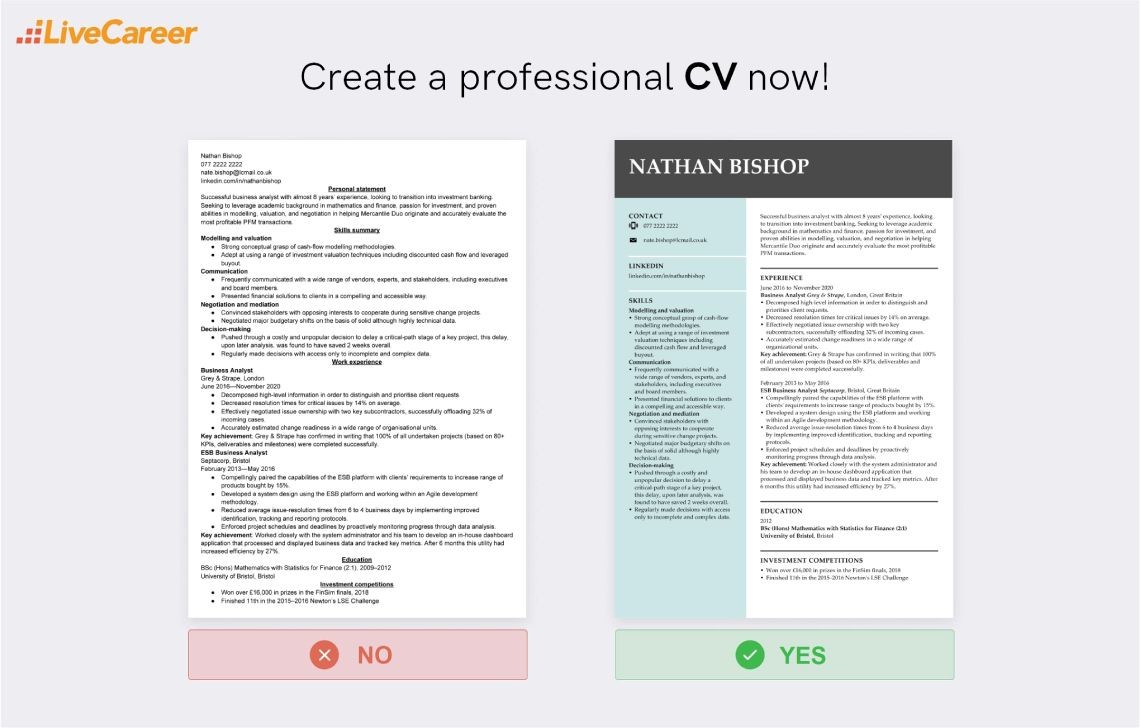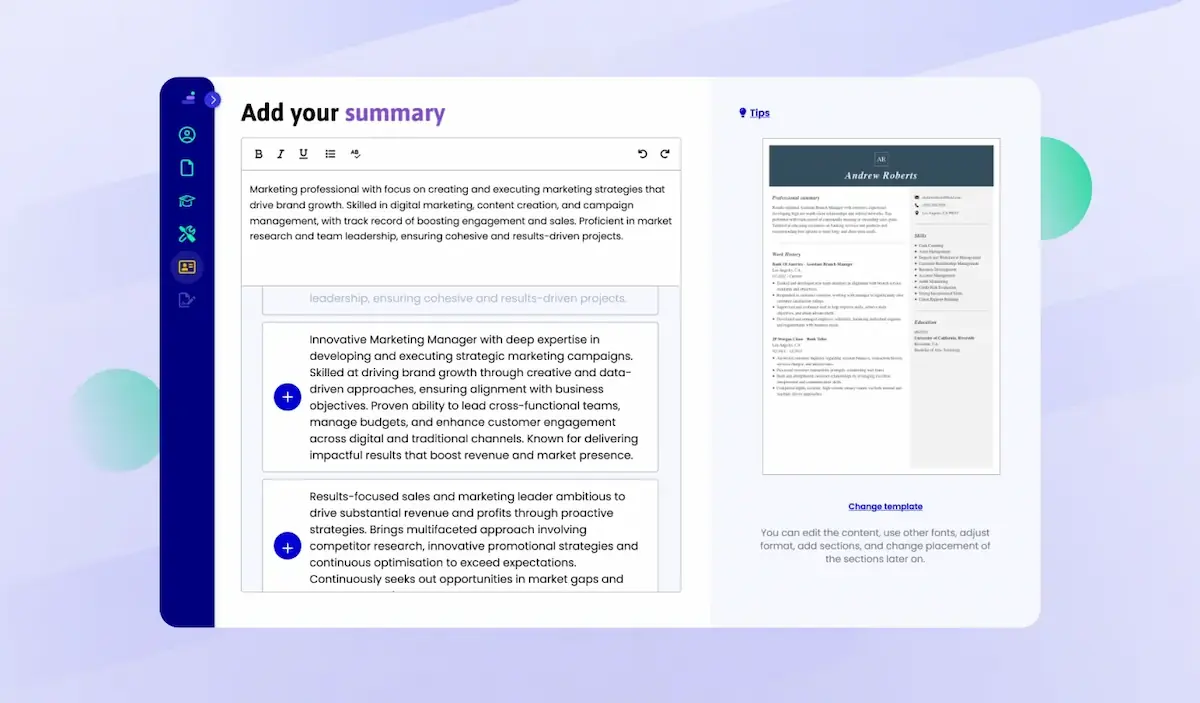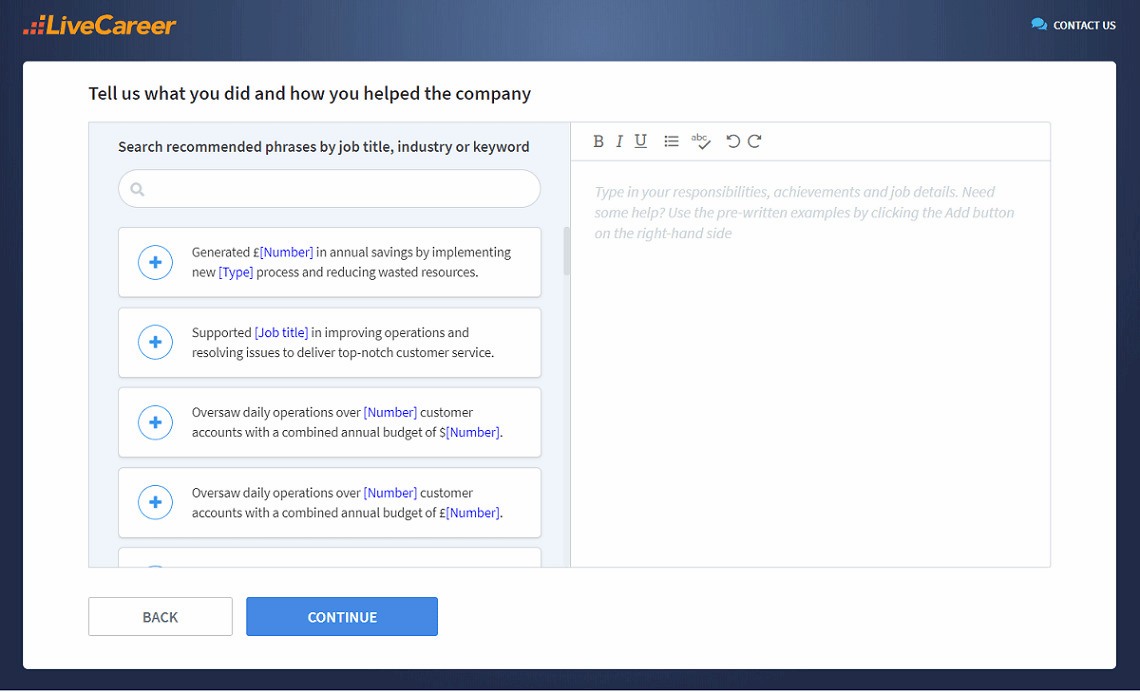
How to Write a Speculative CV (+ Examples)
Apply for jobs before they’re advertised. In this guide, you’ll learn how to make a speculative CV that puts you miles ahead of your competition.
November 13, 2025
Last updated on 9 December, 2025

Switching from one job to another is challenging enough, but transitioning from one career to another is something else entirely. And yet it’s becoming more and more common. In the best case scenario, you’re striking out and finally following your dreams. In the worst, your previous career has become untenable.
This article is here to guide you in writing a CV for a career change that will get you to the interview stage in such style that you won’t feel the need to explain once you’re there. With plenty of career change CV examples and good advice, you’ll be clicking send as you smile at the possibilities in no time.
Create an effective CV in minutes. Choose a professional CV template and fill in every section of your CV in a flash using ready-made content and expert tips.

We created the sample on the right using our builder. See other good CV examples like this one.
Looking for a different job? See our other CV guides:
Haven't found your job? See our other CV examples.
Nathan Bishop
077 2222 2222
nate.bishop@lcmail.co.uk
linkedin.com/in/nathanbishop
Personal statement
Successful business analyst with almost 8 years’ experience, looking to transition into investment banking. Seeking to leverage academic background in mathematics and finance, passion for investment, and proven abilities in modelling, valuation, and negotiation in helping Mercantile Duo originate and accurately evaluate the most profitable PFM transactions.
Skills summary
Modelling and valuation
Communication
Negotiation and mediation
Decision-making
Work experience
Business Analyst
Grey & Strape, London
June 2016—November 2021
Decomposed high-level information in order to distinguish and prioritise client requests.
Key achievement: Grey & Strape has confirmed in writing that 100% of all undertaken projects (based on 80+ KPIs, deliverables and milestones) were completed successfully.
ESB Business Analyst
Septacorp, Bristol
February 2013—May 2016
Compellingly paired the capabilities of the ESB platform with clients’ requirements to increase range of products bought by 15%.
Key achievement: Worked closely with the system administrator and his team to develop an in-house dashboard application that processed and displayed business data and tracked key metrics. After 6 months this utility had increased efficiency by 27%.
Education
BSc (Hons) Mathematics with Statistics for Finance (2:1), 2009–2012
University of Bristol, Bristol
Investment competitions
Now, that's a modern CV template! Here’s how to write a CV for a career change, with expert career change CV examples included:
Your career change personal statement (also called a CV profile or a CV summary) is the perfect opportunity to frame the rest of your CV, set the tone, and establish a narrative for your career change. It’s where you’ll introduce yourself, indicate what it is that you can offer your new employer, and show that your goals align with those of the company.
This is a lot to achieve in just 50–150 words. Normally, you’d write 3–4 sentences here, but since a career change CV may take a little more framing, you might need as many as 3–5 sentences. Do keep it as short as you possibly can, though. The more you write, the less likely it is to be read.
Your aim here is to answer three questions:
Normally, you’d approach the second point by including an achievement from your current/previous job. This might work in a career change CV, but then again the contexts might just be too different. In such cases, focus on the skills and knowledge you bring to the role and the company.
Your responses to the second and third points above need to be filtered through what the company needs. You can find out what the company needs by doing some background research. Scour the internet for information on the company. Figure out what it values and what its goals are.
The first barrier your application is likely to have to overcome is an Applicant Tracking System (ATS). Outsmart it by mentioning the company by name as well as the position for which you’re applying as it appears on the job advert. Mirror keywords used in the job advert wherever possible, too.
Your personal statement comes first in your CV, but it’s going to be much more effective if you leave writing it until last. You’ll be able to do a much better job once you’ve got your skills summary and job descriptions ready. Keep it at the back of your mind as you push on and come back to it later.
Successful business analyst with almost 8 years’ experience, looking to transition into investment banking. Seeking to leverage academic background in mathematics and finance, passion for investment, and proven abilities in modelling, valuation, and negotiation in helping Mercantile Duo originate and accurately evaluate the most profitable PFM transactions.
A strong CV summary will convince the recruiter you’re the perfect candidate. Save time and choose a ready-made personal statement written by career experts and adjust it to your needs in the LiveCareer CV builder.

The fact that you’re looking for information on how to write a CV for a career change suggests that you realise that the typical reverse-chronological CV format just isn’t going to cut it here. You might come across some opinions that a skills-based CV format is best for a career change CV, but there’s a better way.
A hybrid (or combination) CV format is a combination of the default (reverse-)chronological format and the less common skills-based (or functional) CV format. The hybrid CV format is even less common in the UK than a skills-based format, but it’s the perfect choice for a career change CV.
A hybrid CV format puts your skills front and centre, and in an expanded form. This is perfect for someone transitioning from one career to another. Unlike a skills-based CV format, though, it doesn’t reduce your work history to just a job title, company name and location, and dates of employment.
It’s also close enough to a chronological CV that hiring managers and recruiters can scan through it without missing a beat. ATSs can also parse a hybrid CV fairly easily without getting tripped up nearly as much as they do with skills-based CVs. This CV format will give you the best possible shot at landing interviews.
To prepare your skills summary, choose 3–4 transferable skills to put into your CV. This means nothing more than finding 3–4 skills that you developed and used in your previous career that are also amongst the most sought-after in your new career and in this job to which you’re applying in particular.
Add 1–2 bullet points to each skill that describe exactly how you’ve demonstrated that skill in a work context or that in some other way go towards proving that you really do posses the given skill. Be as specific as possible and put numbers to everything you can. The more concrete, the more convincing.
Modelling and valuation
Communication
Negotiation and mediation
Decision-making
One huge advantage for career changers of a hybrid CV format over a skills-based CV is that you can still do your work history justice by elaborating on each job description. Start by generating a subheading for each of your previous positions. Use this career change CV template to keep the layout consistent:
[Job Title]
[Company Name, Location]
[Dates of Employment]
Populate each job description with 3–5 bullet points describing your job. Try to quantify these bullet points wherever possible—aim to make it something more than just a list of duties. Ideally, each point would be in the form of an accomplishment statement, structured using something like the STAR method.
All your bullet points should be relevant to the job to which you’re applying, but pick out one achievement from each former job that is particularly impressive and relevant in the context of your application. Feature this point as a key achievement, and make sure it’s fully quantified and as specific as possible.
Business Analyst
Grey & Strape, London
June 2016—November 2021
Decomposed high-level information in order to distinguish and prioritise client requests.
Key achievement: Grey & Strape has confirmed in writing that 100% of all undertaken projects (based on 80+ KPIs, deliverables and milestones) where completed successfully.
ESB Business Analyst
Septacorp, Bristol
February 2013—May 2016
Compellingly paired the capabilities of the ESB platform with clients’ requirements to increase range of products bought by 15%.
Key achievement: Worked closely with the system administrator and his team to develop an in-house dashboard application that processed and displayed business data and tracked key metrics. After 6 months this utility had increased efficiency by 27%.
Your education can be the common ground from which your next career sprouts just like the previous one did before it. Even if you feel your education isn’t directly relevant to the job to which you’re currently applying, you need to include a clear and concise education section in your career change CV.
List your academic qualifications is reverse-chronological order. There’s no need to mention your high school education if you have a university degree. Likewise, there’s no need to list university subjects or grades of any kind (aside from degree classes). Include an expected graduation date if you’re still studying.
Use the following career change CV template for both university degrees and other tertiary qualifications:
[Degree Type] [Degree Name](Degree Class), [Years Attended]
[Institution Name], [Institution Location]
Use the following templates to detail your high school education if you don’t have a university degree:
A-levels: [Subject Name 1], [Subject Name 2], [Subject Name 3]
[School Name], [School Location], [Years Attended]
[n] GCSEs (including Mathematics and English)
[School Name], [School Location], [Years Attended]
(n = the number of GCSEs you completed).
BSc (Hons) Mathematics with Statistics for Finance (2:1), 2009–2012
University of Bristol, Bristol
It’s always a smart idea to make good use of additional sections in a CV. It’s more like a necessity when writing a CV for a career change, though. Your skills should always align well with your new career choice, but your experience mightn’t look as conducive to a seamless transition on paper.
Adding extra sections to your career change CV can smooth over the way your career change comes across on paper. That’s on top of its primary function, which is painting a fuller, higher resolution portrait of you as an employee. So include sections that show how and why you’re suited to the role.
You can add sections that detail your additional qualifications and certifications, achievements, awards, accolades, even hobbies and personal interest. Do you speak any languages other than English? Speaking a foreign language is always an advantage, even if you’ll never have the opportunity to make use of your ability directly.
The only criteria in deciding whether to include a particular extra section in your career change CV are relevance and space. Everything you add has to be relevant to the job at hand. If it’s not, then it has to go. If you’re low on space, then what you’re adding has to also be more valuable that whatever it displaces.
Investment competitions
No job application is complete without both a CV and a cover letter, but a well-written cover letter is even more important when it comes to submitting a career change CV. A career change cover letter is where you can really address your career transition, the motivations behind it, and the unique benefits it brings.
A career change cover letter will need to follow the standard UK business letter format just like any other. It should end up being roughly 250–400 words long and should nicely fill an A4 page without going over. It will not, however, cast your career change in a negative light or apologise for your lack of experience.
A well-structured career change cover letter will include a standard header, an appropriately formal salutation, a strong opening paragraph, a compelling showcase of your achievements, a closing paragraph that includes a confident CTA, and a sign-off that matches the salutation you chose.
You should always include a cover letter (whether you’re changing careers at the time or not), with the one and only exception being if you’ve been explicitly told not to include a cover letter. Like so much of your career change CV, you’ll be writing a new career change cover letter for each new job application.
One thing that virtually all employers look for in an employee is attention to detail. Put your attention to detail on display by making sure you have flawless spelling and grammar throughout. Achieve this by proofreading, using software and web apps, as well as getting someone else to read over your work.
Take care of the overall look and readability of your career change CV. Leave your contact details near the top of your CV. Use plenty of white space around sections and subsections of your CV. Choose a professional CV font like Noto, Arial, Liberation, or even Calibri and leave the size at 11–12 points.
Use standard 2.5 cm margins and keep your CV layout as symmetrical and balanced as possible. Keep to a one-page maximum length whenever possible. If you have 20 years or more of experience, then extend this to two pages maximum. Always use PDF unless explicitly asked for something less stable.
And something to keep in mind after sending your career change CV: follow up if you haven’t heard back after a week or more. All it takes is a short email or a quick phone call and it could make all the difference for your application. If nothing else, you’ll have made a good impression and received an update.
You don’t have to be a CV writing expert. In the LiveCareer CV builder you’ll find ready-made content for every industry and position, which you can then add with a single click.

Did you like our career change CV sample? Would you like me to expand on anything I’ve mentioned here? Please leave any questions, comments or experiences down below.
Our editorial team has reviewed this article for compliance with LiveCareer’s editorial guidelines. It’s to ensure that our expert advice and recommendations are consistent across all our career guides and align with current CV and cover letter writing standards and trends. We’re trusted by over 10 million job seekers, supporting them on their way to finding their dream job. Each article is preceded by research and scrutiny to ensure our content responds to current market trends and demand.
Category: CV Examples
Crafting a job-winning CV is all about showcasing your unique skills and experiences. Start with a strong personal statement that highlights your career goals and achievements.
Try Our CV Builder Now